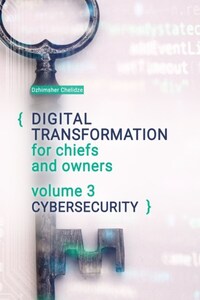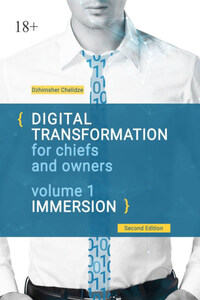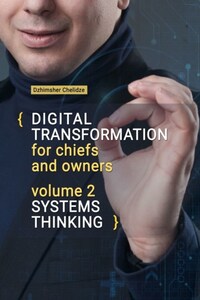Cover designer Alexander Peremyshlin
Illustrator Alexander Peremyshlin
Editor Alexander Peremyshlin
© Dzhimsher Chelidze, 2024
© Alexander Peremyshlin, cover design, 2024
© Alexander Peremyshlin, illustrations, 2024
ISBN 978-5-0064-4211-5 (т. 3)
ISBN 978-5-0064-2489-0
Created with Ridero smart publishing system
Hello, dear reader. This is the final book on digitalization and digital transformation. In the first book, we looked at what digitalization and digital transformation are, why they are needed, what is the difference, what are the pitfalls. In the second they were introduced to the system approach, which is applicable not only for digital transformation, but also in general for any business. The system approach combines proven tools and digitalization, is accessible to anyone and aims to increase the impact of digital technologies, as well as to minimize the risks associated with the organization of work. At the same time, in the first part we talked that in the role model for digital transformation a specialist in information security is needed. Additionally, this is the direction I decided to devote a separate book.
It would seem that digitalization and cyber-free are incompatible, but it is impossible to continue digitalizing without befriending them. Recently at Denis Batrankov I have met a good definition of why it is necessary to deal with information security now: Previously, security was built on the story of the shark: you do not need to be ahead of everyone floating from it – enough to be ahead of the latter. However, now, when you are the target of the shark – it is more difficult to defend”. Additionally, this definition very accurately describes the current situation, as every year hackers’ attacks become more targeted. Additionally, 2022 in general became a landmark.
This book would not have been without the research of Positive Technology (hereinafter – PT), which became my first guides to the world of cybersecurity. Additionally, if you like to immerse yourself thoroughly in the primary sources, details, I recommend you study these studies. QR codes and links to them will be at the end of the book.
The book consists of three parts. The first is devoted to the review and analysis of the current situation. There will be many numbers, statistics, analysts, money. The task of the first part – to form your awareness of the problem and the understanding that information security (hereinafter – IS) – is a direction as strategic as all digitalization, and it is worthy of your attention. The main thesis is at once – a bottleneck in security, as in all digitalization – processes and people, not only yours, but also in the team of software developers (further – software).
The second part deals with the integration of information security from a systems perspective.
![]()
Well, the third part is devoted to practical recommendations on what to do here and now, how to choose IT solutions for information security, what people need to know and what competencies are needed.
If you’ve read previous books, you already know my approach – to control someone and delegate tasks, to trust your team, you need at least a basic understanding of its work. And the key task of the whole book is to give you the basic knowledge to build effective work with your team and the IS Director (hereinafter – CISO) with the least labor and risk for you.
Additionally, to avoid any misunderstanding, let’s look at the difference between information security and cybersecurity?
Information security is an activity that involves the prevention of unauthorized access, use, disclosure, distortion, modification, research, recording or destruction of information.
Cyber security is all the same, only related to IT systems and computers.
Part 1. Why deal with information and cybersecurity?
Chapter 1. Immersion and About Money
In 2023, it is already obvious that without the use of digital technologies it is impossible to conduct business, live comfortably, and manage the state.
If we talk about public services, public services in the form of online services are developing around the world. Russia is among the world’s leaders. I, for example, I use the state’s digital services to record a child to a doctor, and to view his vaccinations with test results, and to pay fines, taxes, tax returns.
If we talk about the commercial sector, it can no longer without online: payment for goods, booking tickets, receiving services, consultations, the appearance of digital advisers.
In general, digitalization and automation everywhere. Additionally, if you ignore them, you will be simply uncompetitive. Additionally, if you want to understand what is waiting for us in about 5—10 years, I recommend reading the observations of Yevgeny Bazhov about what is happening in China, in his book Made in China. How to conduct online business in Chinese”.
Let us also, for example, touch on the work with personnel. Without cloud technology and hybrid / remote operation, it will be much more difficult for you to attract talented employees and/or you will significantly overpay for them. Yes, the labor market is changing, of course, and now again the employer is starting to dictate its terms to the average worker. However, this is about the average worker. Additionally, if you want to attract talent, removing is a powerful advantage. According to my personal observations the removal/hybrid saves up to 30—40% on the wage fund. Young, flexible, hungry to the success of the company are actively using it. Additionally, one of the tendencies I see in job openings is that people who want to pay less just give you the opportunity to work remotely. Of course, I do not keep detailed statistics on the closing dates of these vacancies, but they close quickly. It seems even faster than companies with higher salaries, but the requirement to be present at the office daily.











